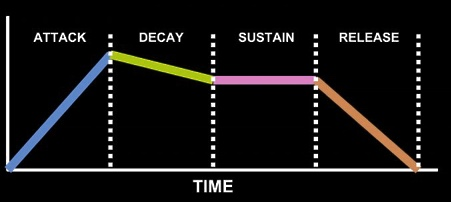Envelope
What is it?
The envelope of a sound is the journey that the sound takes from its inception to its ultimate completion. In other words, it describes how a sound changes over time.
- there are various types of envelope
- ex. an amplitude envelope describes how the amplitude of a sound changes over time
- amp envelopes are most common, particularly when talking about acoustic (ie. non-digital) sounds
- ex. an amplitude envelope describes how the amplitude of a sound changes over time
consider the plucking of a guitar string. As we hit the string, the sound reaches its absolute peak.
Instruments don't make sounds the way lamps make light: it's not "all" or "nothing."
- instead, the sound wave is composed of 4 sections:

ADSR
The combination of ADSR describe how a sound changes over time.
Attack
The attack controls the time taken for the sound to reach its peak from nil.
- in the case of an amplitude envelope, it is the part of the envelope where amplitude is still increasing.
- In other words, it is the time taken for amplitude to reach max level.
Most natural instruments have a very short attack, meaning they reach max amplitude very quickly.
A slow attack can be perceived as a sort of fade-in— as we press the key down, it takes a more significant amount of time before the sound reaches its peak amplitude.
Decay
The decay controls the time taken for the envelope to decrease from its peak to the sustain level.
- in the case of an amplitude envelope, the part where amplitude starts to decrease. This phase starts as soon as the attack phase reaches its peak.
- in real spaces high frequencies often decay quite fast while bass frequencies stick around much longer.
Sustain
the period during which amplitude remains constant
- many natural instruments (e.g. guitar) don't have a sustain phase
While attack, decay, and release refer to a length of time, sustain refers to level (e.g. in case of amp envelope, a volume level).
- often, sustain is quantified by a % of the peak value
- ex. with an amplitude envelope, a sustain of 70% means that the sustain phase of the envelope is at 70% of the amplitude of the peak's amplitude value.
Release
the final reduction in amplitude.
On piano, this would be the time it takes for the sound to reach 0 amplitude after we take our finger off the key.
Example: envelopes of different instruments
ex. If you press a piano key and release it, the sound changes volume gradually over time.
-
First, it rises quickly (or "attacks") to its maximum volume.
-
Next, the sound "decays" to a lower level and stays there or "sustains."
-
Finally, when we let go of the key, the sound "releases" and dies down to silence.
-
In a piano, the attack phase is fairly slow and the sustain phase can be really long as the notes take a long time to die away.
-
ex. With a flute, the attack phase is quicker and sharper, there is little decay, the sustain continues for as long as the flautist keeps blowing, and the release is also very fast.
-
ex. With the strike of a drum, you have an almost instant attack, a longer decay (depending on what material you're hitting), and effectively no sustain or release.
Backlinks